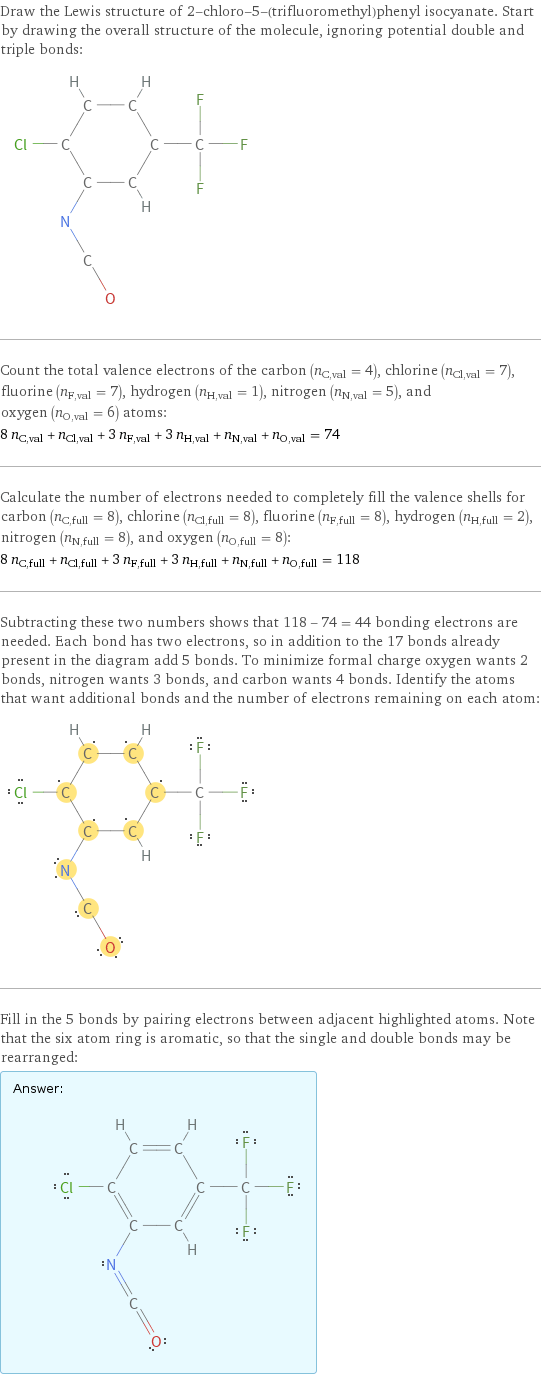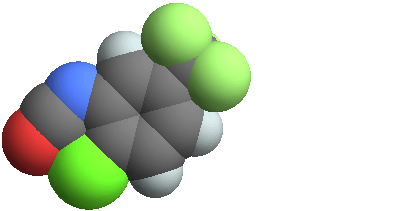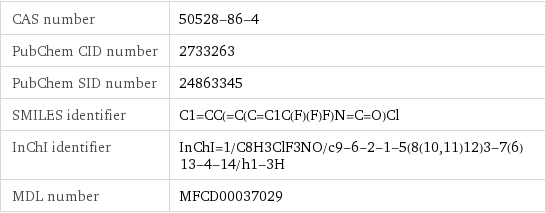Input interpretation

2-chloro-5-(trifluoromethyl)phenyl isocyanate
Chemical names and formulas

formula | ClC_6H_3(CF_3)NCO Hill formula | C_8H_3ClF_3NO name | 2-chloro-5-(trifluoromethyl)phenyl isocyanate IUPAC name | 1-chloro-2-isocyanato-4-(trifluoromethyl)benzene alternate names | 1-chloro-2-isocyanato-4-(trifluoromethyl)-benzene | 1-chloro-2-isocyanato-4-(trifluoromethyl)benzene | 6-chloro-a, a, a-trifluoro-m-tolyl isocyanate mass fractions | C (carbon) 43.4% | Cl (chlorine) 16% | F (fluorine) 25.7% | H (hydrogen) 1.36% | N (nitrogen) 6.32% | O (oxygen) 7.22%
Lewis structure

Draw the Lewis structure of 2-chloro-5-(trifluoromethyl)phenyl isocyanate. Start by drawing the overall structure of the molecule, ignoring potential double and triple bonds: Count the total valence electrons of the carbon (n_C, val = 4), chlorine (n_Cl, val = 7), fluorine (n_F, val = 7), hydrogen (n_H, val = 1), nitrogen (n_N, val = 5), and oxygen (n_O, val = 6) atoms: 8 n_C, val + n_Cl, val + 3 n_F, val + 3 n_H, val + n_N, val + n_O, val = 74 Calculate the number of electrons needed to completely fill the valence shells for carbon (n_C, full = 8), chlorine (n_Cl, full = 8), fluorine (n_F, full = 8), hydrogen (n_H, full = 2), nitrogen (n_N, full = 8), and oxygen (n_O, full = 8): 8 n_C, full + n_Cl, full + 3 n_F, full + 3 n_H, full + n_N, full + n_O, full = 118 Subtracting these two numbers shows that 118 - 74 = 44 bonding electrons are needed. Each bond has two electrons, so in addition to the 17 bonds already present in the diagram add 5 bonds. To minimize formal charge oxygen wants 2 bonds, nitrogen wants 3 bonds, and carbon wants 4 bonds. Identify the atoms that want additional bonds and the number of electrons remaining on each atom: Fill in the 5 bonds by pairing electrons between adjacent highlighted atoms. Note that the six atom ring is aromatic, so that the single and double bonds may be rearranged: Answer: | |
3D structure

3D structure
Basic properties

molar mass | 221.56 g/mol phase | liquid (at STP) boiling point | 63.5 °C (measured at 666.5 Pa) density | 1.48 g/cm^3 solubility in water | insoluble
Units

Liquid properties (at STP)

density | 1.48 g/cm^3 refractive index | 1.489
Units

Chemical identifiers

CAS number | 50528-86-4 PubChem CID number | 2733263 PubChem SID number | 24863345 SMILES identifier | C1=CC(=C(C=C1C(F)(F)F)N=C=O)Cl InChI identifier | InChI=1/C8H3ClF3NO/c9-6-2-1-5(8(10, 11)12)3-7(6)13-4-14/h1-3H MDL number | MFCD00037029
NFPA label

NFPA label

NFPA health rating | 2 NFPA fire rating | 2 NFPA reactivity rating | 0
Safety properties

flash point | 92.22 °C

DOT hazard class | 6.1 DOT numbers | 2206